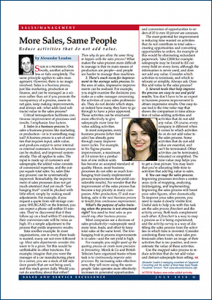 Sales is a profession. One excels, another achieves less or fails completely
Sales is a profession. One excels, another achieves less or fails completely
The same principle applies to sales management. However, there is no magic involved. Sales is a business process, just like marketing, production or finance, and can be managed as a science rather than art if you promote the transparency of a process, assess its net gain, keep making improvements, and always ask: what adds (and subtracts) value to the sales process?
Critical introspection facilitates con-tinuous improvement of processes and results. I emphasize four factors:
1. Sales is a business process. Is sales a business process like marketing or production—or is it something magical? A business process is a set of activities that requires input, adds value, and produces output to serve internal or external customers. A business process can be studied, and improved systematically. This all applies to sales. The input is made up of customers and salespeople, the added value consists of commercial expertise, and the out-put equals total sales. So, sales (like any process) can be systematically improved. Remarkably, the improve-ment of sales processes does not get much attention! And yet much “low hanging fruit” could be plucked with little effort, simply by making small adjustments. For example, if you request a quote from self-storage com-pany SHURGARD on the Internet, you can expect a phone call within 15 min-utes. They’ve discovered that if they follow up on a lead within 15 minutes, their conversion-rate will be twice as high. It’s a simple adjustment to the process that yields impressive results.
Take another example. In most organizations, one in every three leads is wasted; many are not even followed up. Most sales departments consider this waste to be a given. Yet this would be unthinkable in other functions. For example, imagine that you were the manager of a car manufacturing plant. In a corner, you see a stack of left side door panels that are not being used, and this stack grows daily. Would you not do anything about that either? Then why do you allow the same thing to happen with the sales process? What makes the sales process more difficult to manage is that its main means of production are people—and people are harder to manage than machines.
2. There’s much room for improvement in the average sales process. In the area of sales, impressive improve-ments can be realized. For example, you might examine the decisions you make as a sales manager concerning the activities of your sales profession-als. They do not decide which steps, or indeed how many, they have to go through to have a price approved. Those activities can be structured more effectively to give salespeople more time for value adding activities.
In most companies, every business process (other than sales) has already gone through many improvement cycles. For example, in Six Sigma process improvement, a maximum of 3.4 errors for a production of one million units has become an accepted standard of quality. Hence, most business processes do not offer as much low-hanging fruit (easily implemented process improvements that yield considerable results). No wonder that the improvement of the sales process has become a top priority in many com-panies. After production, IT and mar-keting, sales is the next business process to benefit from continuous improvement.
What’s the purpose of sales training when the process is not structured right? You need to treat sales as you would any other business process.
Most companies see a decrease of sales productivity—salespeople need more time, leads, and effort to keep total sales at the same level. The low-hanging fruit in process improvements is in sales—and the net yield is high.
For example, you might speed up the quoting process or create more precision in forecasting. Merck & Co and British Telecom have organized teams whose task is to continuously improve sales processes. By increasing sales effectiveness, they sell more using the same people. Sales operates more effectively: increases in generated opportunities and conversion of opportunities to orders of 10 to even 50 percent are common. The most potential for improvement is reducing time wasted on activities that do not contribute to total sales— creating opportunities and converting opportunities to orders. An example of this would be eliminating redundant paperwork. Take CRM for example: salespeople may be forced to fill out every field on every form, although the information is never used, and does not add any value. Consider which activities to terminate, and which to relocate or simplify. Always ask: Does this add value to the sales process?
3. Several tools that help improve the process are easy to use and yield results. You don’t have to be an expert in business process improvement to obtain impressive results. One easy-to-use tool is the time-value map that shows the comparison in time allocation of value-adding activities and activities that do not add any value. Of course, every company is different when it comes to which activities do or do not add value to the sales process. Some activities that do not add value are essential, and can’t be terminated. Other activities can be terminated, relocated or simplified. The time-value map helps you to get a clear picture. You may learn that you’re allocating little time to activities that add big value to sales.
4. You can map the sales process. Improving processes involves a continuous cycle of mapping, analyzing, (re)designing, and implementing. Improving the sales process will boost your sales figures, often dramatically. To improve your sales process, you need to make it clearly visible first. Useful aids to help you with this task are the sales process flowchart and the activity survey. Both tools complement each other. A flowchart is a way to map a process as it is being experienced, and the activity survey is a way of distilling the sales process from the activities in which time is invested. Consider combining these tools, since sales professionals often foster an image of their activities that is too positive, and overestimate the value of these activities.
Use the mapped sales process to reduce activities that do not add value and distract salespeople from selling.
This article was published in Sales and Service Excellence magazine (US) and can be downloaded via this link.
 Meer weten?
Meer weten?
Neem contact op met Alexander Loudon: bel gerust 020-3585746 of mail moc.setaicossanoduolnull@rednaxela.

